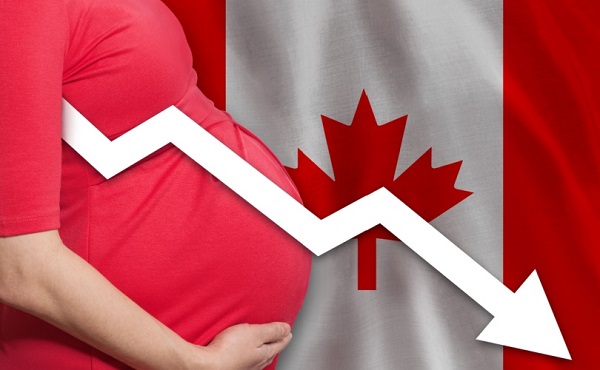COVID-19
Canada reports 300% increase in ‘unspecified causes’ of death, sparking calls for investigation

From LifeSiteNews
This article was originally published by The Defender — Children’s Health Defense’s News & Views Website.
By Mike Capuzzo
A new Canadian government report reveals a 300% rise in ‘unspecified causes’ of death from 2019-2022 as unknown causes climbed to the fifth leading cause of death in Canada. Some health experts said the stark increase should trigger an investigation into whether the deaths are linked to COVID-19 vaccines.
As life expectancy plummets in Canada, a new government report claims “unspecified causes” have become the fifth leading cause of death in the country after cancer, heart disease, COVID-19, and accidents.
According to the Statistics Canada report, “unspecified causes” in 2022 passed strokes, aneurysms, chronic bronchitis, emphysema, asthma, diabetes, influenza and pneumonia, chronic liver disease and cirrhosis, Alzheimer’s, and suicide as causes of death.
Statistics Canada, also known as StatCan, released the report on November 27 in The Daily, the agency’s online news bulletin.
The report generated a slew of nearly identical headlines – provided by Canada’s national news service – in Canada’s leading newspapers along the lines of this one in the Toronto Sun: “Life expectancy for Canadians fell for third straight year in 2022, StatCan says,” followed by the subhead: “More people died of COVID-19 in 2022 than in any other year since the pandemic began, report says.”
Andre Picard, health columnist at The Globe and Mail in Toronto, Canada’s newspaper of record, called the life expectancy drop – to 81.3 years in 2022 from 82.3 years in 2019 – “a big deal.”
“It’s only the second time this sharp a drop has happened in Canada in the past century,” Picard said. “In fact, life expectancy has been climbing steadily for decades: 71 in 1960, 75 in 1980, 79 in 2000 and 82.3 in 2019.”
COVID-19 deaths can’t account for Canada’s 7.3 percent increase in total deaths in 2022 compared with 2021 – or for the country’s 17 percent increase in total deaths over the historic norm of 2019, or the historic drop in life expectancy in Canada and worldwide, Picard said.
Like many mainstream journalists and public health officials in the U.S. examining the U.S. drop in life expectancy, Picard blamed chronic diseases, drug overdoses, opioid deaths, smoking, unhealthy diets, and “indifference” for the decline in Canada. “There are virtually no mitigation measures like masking any more, and vaccination rates have fallen sharply,” he wrote.
But Drs. Pierre Kory and Peter McCullough told The Defender they believe the most important and startling fact contained in the report is the 300 percent increase from 2019 to 2022 in “unspecified causes” of death in Canada.
McCullough, a highly published cardiologist who developed a widely used early treatment protocol for COVID-19, said the dramatic rise in deaths from “unspecified causes” in Canada represents a seismic and disturbing shift in Western medicine.
“Prior to the pandemic, death in Western countries was well understood,” McCullough said, with 40% due to known cardiovascular, 40% due to terminal neoplastic disease (cancer) and 20% due to other known causes such as homicide, suicide, drug overdoses and accidents.”
He added:
Since the roll-out of the COVID-19 vaccines, we have witnessed unprecedented deaths without antecedent disease. A large autopsy series published by Hulscher et al., found that 73.9% of the deaths after COVID-19 vaccination were due to problems caused by the shots.
McCullough cited the hundreds of studies examining post-vaccine, spike-protein-related injuries and deaths and the millions of deaths and injuries reported by citizens in the U.S. and Europe to their governments following mRNA vaccination.
“All deaths should be categorized according to the doses and dates of COVID-19 vaccination,” McCullough said. “Unless proven otherwise, ‘unspecified death’ should be attributed to a fatal COVID-19 vaccine injury syndrome,” McCullough said.
Kory, the former University of Wisconsin professor of medicine and president of the Front Line COVID-19 Critical Care Alliance, told The Defender the evidence is overwhelming that the COVID-19 mRNA shots caused more deaths and injuries across the Western world than any prior drug or vaccine in history.
“The answer as to why ‘unspecified causes’ are now a leading cause of death is plain and simple,” Kory said. “That cause is the one medical intervention that the world’s governments and media have championed since the start [of the pandemic]… The mRNA platform technology is and has been a colossal failure in both efficacy and safety.”
Kory and journalist Mary Beth Pfeiffer on Tuesday published an opinion piece in The Hill calling on governments and public health officials to study and address the problem of a global historic rise in mortality thus far not recognized by officials and not reported by mainstream journalists.
On December 13, the essay was trending as the first or second most popular story on The Hill’s website, which claims 32.5 million monthly unique visitors.
U.S. Food and Drug Administration (FDA) Commissioner Robert Califf on November 30 published an extraordinary thread of posts on X (formerly Twitter) calling for a society-wide “all hands on deck” approach to solve the problem of the “catastrophic” decline in U.S. life expectancy.
“JAMA Internal Medicine published earlier this month that our overall life expectancy has dropped to 76 years, and remarkably, that male life expectancy in the U.S. has dropped to 73 years,” Califf wrote.
But Kory said the FDA commissioner’s post, “which hit on smoking, diet, chronic illness and healthcare, ignored the obvious: People are dying in abnormally high numbers even now and long since COVID waned. Yet public health agencies and medical societies are silent.”
The FDA and mainstream media are ignoring the fact that life insurers have been “sounding the alarm over these unexpected or, ‘excess,’ deaths, which claimed 158,000 more Americans in the first nine months of 2023 than in the same period in 2019,” Kory wrote.
“That exceeds America’s combined losses from every war since Vietnam. Congress should urgently work with insurance experts to investigate this troubling trend.”
Amy Kelly, COO of DailyClout and the program director of the Pfizer Documents Analysis Project, said that for an autopsy to reach a proper diagnosis of an mRNA-vaccine-caused death, “histopathological examination of tissues from all over the body is necessary. Most of the time, even if an autopsy is performed, the histopathological examination of tissues is not.”
She cited an interview with Dr. Arne Burkhardt, who describes the types of testing the coroners must perform but seldom do.
Dr. Robert Chandler, a Los Angeles orthopedic surgeon who taught at the University of Southern California medical school, identified “entire new disease categories” he calls “CoVax Diseases” in his study of Pfizer’s 450,000 pages of COVID-19 vaccine documents, documents the FDA was forced to release via a court order, Kelly said.
“It makes sense that the unspecified causes of death have increased so much,” Kelly said. “When a patient dies with either multiple diseases all at one time or with a previously unseen disease state, both of which happen with ‘CoVax Diseases’ Dr. Chandler has identified, I would imagine many doctors and/or coroners don’t know how to categorize those causes of death. That would lead to ‘cause unknown’ categorization of deaths.”
According to Naomi Wolf, author of “Facing the Beast: Courage, Faith and Resistance in a New Dark Age,” “In the preindustrial world, people died mysteriously. But in the modern Western world, there are no mystery deaths. Every death has a death certificate which by law must identify a cause of death.”
“A minor rise in unattributed deaths is a problem that needs investigation,” Wolf said. “A major rise, such as you’ve identified, does not indicate a mass mystery to doctors and coroners, but rather it is evidence of a problem with state record-keeping – some bureaucratic malfeasance at a grand scale.”
This article was originally published by The Defender — Children’s Health Defense’s News & Views Website under Creative Commons license CC BY-NC-ND 4.0. Please consider subscribing to The Defender or donating to Children’s Health Defense.
COVID-19
Devastating COVID-19 Vaccine Side Effect Confirmed by New Data: Study

The Vigilant Fox
In one of the greatest violations of medical ethics in modern history, a new study from South Korea has uncovered devastating consequences from promoting and mandating the COVID-19 injections on the population.
These shots were pushed on babies and pregnant women, directly contradicting the ethical rule against introducing new medical interventions to such vulnerable groups before long-term effects are fully understood.
But they weren’t just aggressively promoted; they were enforced. Refusing the COVID-19 injection could cost you your job, bar you from concerts, businesses, and museums, and, in some cases, even deny you a life-saving surgery unless you complied with the mandate.
Now, as many doctors long warned, the consequences of such reckless health policy are surfacing, and one of the most alarming outcomes is a dramatic rise in cancer risk.
A large-scale population study out of South Korea has now found a 27% overall increase in cancer linked to the COVID-19 injections that were marketed as “safe and effective.”
Dr. John Campbell noted: “There’s a one in a thousand chance that this result arose by chance.” He illustrated the overall cancer rise with a stark graph, as seen in the short video below:
With regard to the details of the study, Children’s Health Defense reports:
The study used data from 2021–2023 for over 8.4 million people in South Korea’s National Health Insurance Service database. The sample was split into two groups based on vaccination status. The vaccinated sample was further split into booster and non-booster groups.
Researchers tracked the patients for one year. The vaccinated group was tracked following vaccination. The results showed a statistically significant higher risk of cancer in the vaccinated group, including:
• Overall cancer: 27% higher risk
• Breast cancer: 20% higher risk
• Colorectal cancer: 28% higher risk
• Gastric cancer: 34% higher risk
• Lung cancer: 53% higher risk
• Prostate cancer: 69% higher risk
• Thyroid cancer: 35% higher risk
These results are nothing short of devastating. Our worst fears have become reality.
And the worst part is that it didn’t have to be this way. Health officials ignored caution, silenced dissent, and turned public health into a reckless experiment.
Now the consequences of such reckless policies have turned the COVID wave into a health tsunami. The longer this issue is ignored, the greater the damage will become. It’s time for health officials to take responsibility for what they’ve done.
COVID-19
Tamara Lich says she has no ‘remorse,’ no reason to apologize for leading Freedom Convoy

From LifeSiteNews
‘To whom shall I apologize? Thousands of Canadians who stopped planning to take their own lives or were able to return to their jobs, kiss dying loved ones or have families over for Thanksgiving?’
Freedom Convoy leader Tamara Lich, reflecting on her recent house arrest verdict, said she has no “remorse” and will not “apologize” for leading a movement that demanded an end to all COVID mandates.
Lich revealed in an X post this week that in conversations with her lawyer, Lawrence Greenspon, over the past few months, she told him, “I would not, and could not, express remorse as it would be dishonest and disingenuous.”
“To whom shall I apologize? The thousands of Canadians who stopped planning to take their own lives when the convoy started? To the thousands of Canadians who were able to return to their jobs? Or should I apologize to all the Canadians who can kiss their dying loved ones or have their families over for Thanksgiving?” she observed.
On October 7, Ontario Court Justice Heather Perkins-McVey sentenced Lich and Chris Barber to 18 months’ house arrest after being convicted earlier in the year convicted of “mischief.”
As reported by LifeSiteNews, the Canadian government was hoping to put Lich in jail for no less than seven years and Barber for eight years for their roles in the 2022 protests against COVID mandates.
Interestingly, Perkins-McVey said about Lich and Barber during the sentencing, “They came with the noblest of intent and did not advocate for violence.”
In Lich’s X post, she noted that while she has “no doubt” some citizens of Ottawa “felt afraid, threatened and terrorized” by the protests, she blamed the Liberal government under former Prime Minister Justin Trudeau.
“How could they not when their mayor and politicians were labeling us as an angry mob coming to overthrow the government before we even left Alberta?” she wrote.
“Do I feel bad for these people? Of course I do. I wish no ill will upon anyone. However, it was their very own leaders who lied to them and misled them. There are citizens in Ottawa genuinely afraid of working-class Canadians, who had never met a trucker or an oil patch worker.”
Lich noted how she told her lawyer that she would “serve 100 years in prison before I will ever apologize.”
Specifically, Barber was handed an 18-month conditional sentence, with a concurrent three-month sentence for counseling disobedience of a court order that can be served in the community.
Lich was given 18 months less time already spent in custody, amounting to 15 1/2 months.
Both Lich and Barber must remain in their house for the first 12 months except for medical emergencies and certain appointments. They are allowed to work and can leave their house for certain permitted activities for up to five hours once a week. They were also given a curfew and 100 hours of community service.
As reported by LifeSiteNews, Barber thanked Conservative MP Leslyn Lewis for “speaking up” in support of him and Canadians’ freedom rights after he and Lich were sentenced.
LifeSiteNews reported that Conservative Party leader Pierre Poilievre offered his thoughts on the sentencing, wishing them a “peaceful” life while stopping short of blasting the sentence as his fellow MPs did.
In early 2022, the Freedom Convoy saw thousands of Canadians from coast to coast come to Ottawa to demand an end to COVID mandates in all forms. Despite the peaceful nature of the protest, Trudeau’s government enacted the never-before-used Emergencies Act (EA) on February 14, 2022.
-

 National2 days ago
National2 days agoCanada’s birth rate plummets to an all-time low
-

 Crime2 days ago
Crime2 days agoPierre Poilievre says Christians may be ‘number one’ target of hate violence in Canada
-

 Opinion21 hours ago
Opinion21 hours agoJordan Peterson needs prayers as he battles serious health issues, daughter Mikhaila says
-

 COVID-1917 hours ago
COVID-1917 hours agoDevastating COVID-19 Vaccine Side Effect Confirmed by New Data: Study
-

 Alberta2 days ago
Alberta2 days agoJason Kenney’s Separatist Panic Misses the Point
-

 Censorship Industrial Complex22 hours ago
Censorship Industrial Complex22 hours agoWinnipeg Universities Flunk The Free Speech Test
-

 Red Deer11 hours ago
Red Deer11 hours agoThe City of Red Deer’s Financial Troubles: Here Are The Candidates I Am Voting For And Why.
-

 Automotive2 days ago
Automotive2 days agoBig Auto Wants Your Data. Trump and Congress Aren’t Having It.






